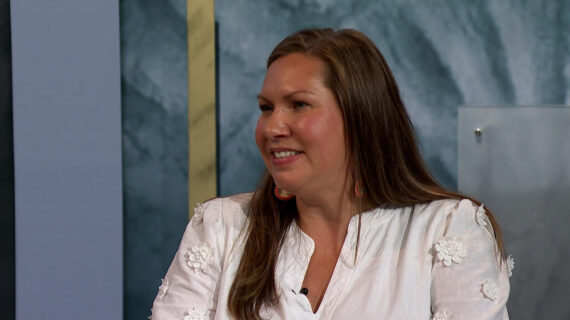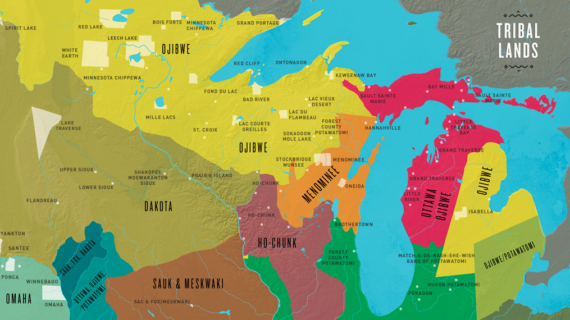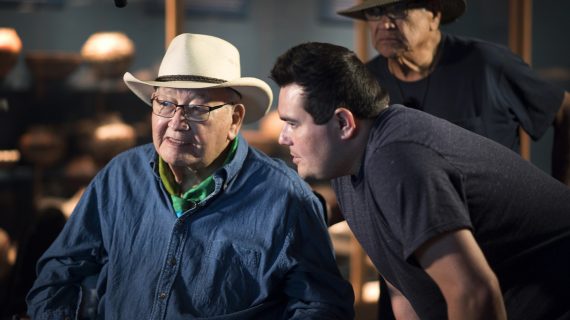– Welcome everyone to Wednesday Night @ the Lab. I’m Tom Zinnen, I work here at the UW-Madison Biotechnology Center. I also work for UW Division of Extension, and on behalf of those folks and our other core organizers, Wisconsin Public Television, Wisconsin Alumni Association, and the UW-Madison Science Alliance, thanks again for coming to Wednesday Night @ the Lab. We do this every Wednesday night, 50 times a year. Tonight, it is my pleasure to introduce to you Donald Mikulic. He is retired from the University of Illinois, and is at the Weis Earth Science Museum at the University of Oshkosh, the campus at the Fox Valley in Appleton. He’s going to talk with us about the impact of the Niagara Escarpment on the development of Wisconsin. As I said in my little missive today, we often say that things are not written in stone necessarily, but when it comes to the history and origins and development of Wisconsin, a lot really is written in the stones and the rocks that are beneath our feet and below the waves. I’m looking forward to hearing about this. Please join me in welcoming Don Mikulic to Wednesday Night @ the Lab.
(audience applause)
(murmured greeting)
– I’m going to talk about not only the Escarpment, the Escarpment is Silurian age rocks, but I’m going to talk about how something that happened 430 million years ago is actually still impacting us as we speak.
The Niagara Escarpment is just a thin edge of Silurian rocks in Wisconsin. And of course many people know that there’s a thing called the Escarpment in Wisconsin. They don’t know much about it. They don’t know why it’s there. And they know it has something maybe to do with Niagara Falls, but it’s always kind of a mystery. It doesn’t have the same notoriety as places like Niagara Falls. So what I’m going to do tonight is I’m going to talk a little bit about how the Silurian rocks and the Niagara Escarpment impact the state. And then I’m going to talk about a couple of other things. I’m going to talk about– This is more about how they impact the state. I’m going to talk about research that was done on these Silurian rocks, historically important research. Some of it done right here by former people of this University. And I’m going to talk about some of my current research that also involves these rocks. So those will be three things, so I’m actually giving three talks in one, so you’re getting a bonus I guess of some sort. So anyways, Silurian, Silurian is a time period, a geologic time period that began about 440 million years ago, and ended about 414 million years ago. If you know anything about the geologic past of North America, most of it was under shallow seas at the time, there was very little in the way of mountains or anything of that nature. There was just shallow seas a few hundred feet deep maybe at the deepest. And at that time what is now, what we’re standing on right now was located about 20 or 30 degrees South of the equator, so we’ve moved a bit. It always impresses me that a lot of the public knows about plate tectonics, which is the unifying theory of geology and is kind of a new concept. When I was a student not too many years ago, there was still a debate about whether or not plate tectonics actually happened or what was going on. But being a young person I readily adapted to it and I took the winning side I guess. And as with most scientific theories, the theory won out because the older people died off.
(audience laughter)
That’s the way science works. So anyways, so if you look at this paleogeographic map, this is what’s currently North America, and right in the yellow is currently the area where the Great Lakes are, and certainly it’s located south of the equator.
So shallow seas, so what would you see in this part of the world at that time? Nothing, just if there’s land there’s no plants of any kind on it except for maybe some moss and things like that, but just basically water.
If you look in the water you find a nice diversity of marine life. There’s all the basic things you’d find in the ocean today are pretty much living then. Fish are a little underrepresented, but everything else is there as we kind of see it. And so looking at the state of Wisconsin, our record is very biased. I always like to explain historical geology as looking at a book with most of the chapters missing, in some random order, because when you look at a section like Wisconsin, and you drill holes down into the ground, you’re only seeing parts of the history, and a lot of it is missing. And in this case, almost all of it’s missing for about the last 350 million years. There’s a major gap there in time. But this is what you would see in Wisconsin and the Silurian is this little area right up in here. So, it’s about 414, 440 million years ago. Some of the youngest rocks we have in Wisconsin. Everything in Wisconsin is marine environment rocks. The Silurian is outcrops, or bedrock surface in Eastern Wisconsin. There’s virtually nothing else in the rest of the state. All of those rocks are older. There’s a few little pieces of Silurian over in the South Western part, and there’s a little bit of Devonian-age rocks, the age of fish, that overlies the Silurian in the Milwaukee area. So what you see and what we’re going to talk about is mostly the Eastern part of Wisconsin, and you can see it’s a very distinctive part of Wisconsin, because it is reflecting the underlying bedrock geology more than anything.
The Niagara Escarpment is this interesting feature. It starts east of Rochester, New York and goes all the way around the Great Lakes, and actually has a lot to do with the current configuration of the Great Lakes, particularly Lake Ontario here on in Michigan. Their borders, their layout is controlled a lot by these Silurian rocks that form the Niagara Escarpment.
This is a more complex geologic map, and here you can see the Silurian has this kind of darker green starting way over in Eastern New York, going around the Great Lakes and coming down here. It does continue farther south but is basically buried there, so it doesn’t have any obvious appearance that you can see impacting anything, it just gets buried under glacial debris. But it is pretty prominent in Wisconsin. Wisconsin has the honor I guess of being either the beginning or the end of the Escarpment, whichever you prefer. It ends in Waukesha County.
So, we got this circular pattern to these rocks, and the basic geology is there’s older rocks surrounding this and there’s younger rocks in the middle here and that’s because we have a structure called a Michigan Basin, which underlies the lower peninsula of Michigan, and it’s simply a downward warping of the rocks. So if you start over in Wisconsin, you see these Silurian rocks in the Escarpment, run into Lake Michigan, they go all the way down, they end up several thousand feet below the ground surface in the middle of Michigan, then they come back up on the other side. So it’s kind of like a big bowl is what you’re looking at. So these Silurian rocks are just a layer of the surface of this bowl.
We have this little thing called Green Bay right here, which is a fairly prominent part of the Escarpment of Wisconsin. We’ll talk a little bit about that. So what’s the definition of an Escarpment? Well you can’t really read that very well because it’s cropped off, but it’s essentially just a kind of a simple structure and it represents actually just a rock face that has virtually no width. It’s just a rock face and it’s representing an edge of outcrop of a specific kind of rock, something that’s sort of cliff-forming separating two other kinds of rocks. So escarpment is very very thin, but in this case it’s one of the longest geologic features in Eastern North America. It’s almost a thousand miles long, which is pretty impressive. Not continuous, but it’s that long. And as I said most people don’t have any idea that it’s actually there or what it is. So this is a little diagram of escarpment. This escarpment is these rock faces here. In most cases you see an escarpment because rocks are tilted and in the case of Wisconsin the Niagara Escarpment the rocks are tilted towards Michigan. If you go on the other side of Michigan, near Ontario, you’re tilted the other way into Michigan because this is a bowl-shaped structure. And it forms cliff faces because it has soft rock underneath, so erosion highlights these more durable rocks at the top, undermines the softer rocks and then eventually you have this collapse. You’re kind of renewing this feature through time. It doesn’t form once and then never change.
And this is a little diagram of showing you that. Here’s a soft rock and a hard rock. And like I said the escarpment is really just this feature right here. Behind that there’s lots of Silurian rocks as you might remember on the map, and that’s called the cuesta. It’s essentially where the Silurian rocks go where they weren’t eroded and in this case they’re going towards the east.
Okay, we owe a lot to our resident first scientist in the state, Increase Allen Lapham. He recognized the Niagara Escarpment in Wisconsin for what it was. It was called locally the ledge back in the mid-1800s, and is still called the ledge by the locals sometimes. Lapham grew up in Western New York. He was very familiar with the escarpment there because he worked on the construction of the locks at Lockport in the Erie Canal, so he was very familiar with this rock body. And he was observant enough to come all the way over to Wisconsin decades later and say “I think this is the ledge that we see in New York”, which is kind of a profound thing because it’s not an obvious connection. It’s pretty far from there and here.
This shows you a map here’s a geologic map again. Here’s Wisconsin, here’s the Silurian rocks, and if you look at all these little red things here these are outcrops of the Niagara Escarpment going down into Dodge County, and they also go down into Waukesha County, the next county down. But they’re basically being covered as you go south. So up in Door County, there’s not a lot of glacial debris in Door County. It’s been pretty much cleaned off by glaciers. They came down and dumped all this stuff to the south, which obscures the escarpment as they go farther south.
The one thing I want to talk a little bit about is we have these Silurian rocks but if you go west we have Ordovician rocks, which are older and are also softer. So there’s a reason why there’s an escarpment in Wisconsin or throughout the Great Lakes area. And that is because you have hard rocks like the Silurian in the middle of two softer bodies of rocks, and so these softer bodies of rocks like these Ordovician rocks in Wisconsin erode away more quickly, because they’re soft, shalely things, and that’s what’s giving the escarpment it’s topography. If you go on one side, you look at this cliff face and everything is eroded away really easily, if you go on the down slope side there’s shale beds there and you don’t get a cliff face, but they also form a depression as you keep going farther to the east.
This shows up very well, this is a cross-section going through Green Bay, so here we have the Silurian rocks tilting into Lake Michigan. We have these Ordovician rocks that have been eroded away in Green Bay. And of course if you didn’t have these Silurian rocks here, you wouldn’t have a Green Bay. And of course that means you wouldn’t have Green Bay Packers because there wouldn’t be a city there. You need the bay there to make a city. So we owe a lot I guess, if you like the Packers, we owe a lot to the Niagara Escarpment.
So this is another diagram again highlighting this tilt. So here’s the edge of the Escarpment. The Silurian rocks tilt towards Lake Michigan. They’re eroded off towards the West, and because of these soft Ordovician rocks, you have erosion going on that way and erosion going down that way. And that coincides to another feature which really highlights a lot of the geology you see and that’s Quaternary glaciation. And the escarpment is actually a dividing line between two giant ice lobes that came down from the north, it divided them. They might have been one farther north, so you have the Green Bay lobe on the west side and you have the Lake Michigan lobe on the east side. So the escarpment is really a profound feature. It’s really characterizing what Wisconsin looks like. If we didn’t have that we wouldn’t have Door County, besides the Green Bay Packers. And you would have just a shoreline without this big projection going out into Lake Michigan.
So I talked a little bit about glacial deposits sort of covering everything, and that sort of obscures our view of things like the escarpment in particular, because as I said the farther south you go the more debris has been piled up by these two glacial lobes running together, and that’s forming what we call the Kettle Moraine of course, which is a very prominent scenic feature of Wisconsin. So that, the Kettle Moraine is there, because of the escarpment, even though the escarpment doesn’t show up. If you talk to Quaternary geologists, a lot of times they talk like all this Quaternary stuff is by itself. It’s actually controlled a lot by the underlying bedrock geology. They don’t talk about that so much.
So here’s an example of the ice sheets that went through this area. Here’s the Lake Michigan ice sheet and the Green Bay lobe and again you can see the escarpment is the thing that divides them. And as you get farther south, the escarpment disappears not because it’s not there, it’s simply buried by all this glacial debris from these lobes coming down.
This is another map showing a little bit better the ice lobe patterns in this area. You can see the soft Ordovician rocks are a conduit for ice flowing between the escarpment and higher ground to the west, and likewise the opposite is occurring in Lake Michigan to the east.
This is a nice diagram from Chamberlin, former president of the university here, his early works of showing this very nicely. Here’s the Kettle Moraine, a nice scenic area in Wisconsin again, and it’s actually controlled by the bedrock geology.
So there’s this geologic underlying to the characteristics of eastern Wisconsin, and controlling this, and there’s a lot of resources and stuff also related to this, because of course resources are controlled a lot by underlying geology. So we have groundwater, good groundwater, potential pollution issues and things like that. We have different kinds of soils that are related to farming. We have natural resources like crushed stone and things of that nature. All of these are dependent on this underlying rock. You go to other parts of Wisconsin, you don’t have Silurian rocks underlying it and you don’t have the same kind of topography or the same kind of geography or the same kinds of resources or ground water or any of those other things. They’re all different because they’re controlled by these geologic features.
So why is this important? Well historically, the Great Lakes and the escarpment are very important because it was one of the ways that the French tried to keep control of North America. They had settlements along Saint Lawrence Seaway of course, and Seaway River. They were trying to connect with land that they controlled in the south, New Orleans. Initially they were exploring towards the west because they were trying to find the Pacific Ocean, but with the exploration by Marquette and Joliet in the 1670s they made a big loop coming down through this area of Wisconsin and came down the Mississippi River, realized this isn’t going to the Pacific, came back up, and then went through probably the most important place in the entire Great Lakes, which is Chicago, because of the portage and connection with the Mississippi River drainage and Great Lakes system. So this was a very important place and even in the 1670s Joliet suggested that a little canal there could connect these waterways and it was eventually built in the 1840s, so quite a lag time there.
This inspired a lot of the settlement and the competition between France and Great Britain.
When those two parties were removed from the area, and this became part of the United States, there was a lot of emphasis to erect forts in places like Chicago because the United States wanted to establish a presence. They didn’t want the British coming back in there and trying to take over. So it was an early conduit for settling even though the waterway there is pretty insignificant and troubled now, bigger now, but it was not very big, but good enough to portage over.
When they started settling this area one of the things they looked for was construction materials. Wood was around a bunch of places. Clay was not all that rare, but stone, which is the big heavy-duty product of those days was very limited in where you can find it. So as early as 1820s, and this is Henry Schoolcraft, talking about what could they do to enhance the presence of the mouth of the Chicago River, because it would sand over all the time. You couldn’t just float a boat down into the Mississippi River Valley. He thought that they could bring stone from Green Bay all the way down there and build an island off the shore, and then connect it by a waterway, I mean a bridge essentially. And so that was a plan and what was also sort of the beginning of the stone industry in the Niagara Escarpment and Door County. Now when people think about the early settlement of Door County they think in terms of wood, cherries, things like that. Actually the first people that were there doing any kind of significant development of resources were people quarrying stone. The government owned the land, and the government would suggest that you go to Green Bay, you go to the North Peninsula, and you get stone there for nothing, and use it on our projects for creating harbors and stuff in various places on Lake Michigan and that would save everybody money and everybody would be happy. So in Door County you have exposures like this where rock comes right up to the shore. In most of the rest of Lake Michigan it’s pretty sparse, particularly the east side of Lake Michigan. There’s very few rock outcrops and even most of the west side that’s south of Door County, rocks are so rare that they become tourist attractions in some cases, so they’re not very common. So it was a very important commodity. If you had to build a harbor you needed stone.
These are some ads from the 1830s, where they’re advertising for people to bid on harbor construction in Michigan and Indiana, and they’re suggesting that you’re going to have to go up and get the stone from Green Bay if you want to get this bid.
So there is a long history of stone quarry operations in Door County. You can still see the remnants of it now. But it was a very important thing because people realized that they could ship stone over the eastern shore of Lake Michigan. It was really valuable. They didn’t have stone. They needed stone to build things. They could burn lime in Door County and sell it to these same people. These are important building commodities that you had to get from somewhere. Because it was on water you could get them fairly cheap. Initially there was no land transportation because there was no roads or railroads or anything like that. And even then, even today it’s still much cheaper to ship things like stone by ships instead of trucks or trains, so it’s still the most economical way to distribute this material. So this is a big industry and it lasts, and here you can see some guys actually building a dock here, and it was a very primitive operation because they would have to load these boats by hand. The idea is that you picked up rocks that you could pick up, so that was kind of the goal of this and throw them in the boat, and then of course, you had to throw them out of the boat when you got there. It cost a lot of money, took a lot of people, but this was the way you did things till about 1900. Finally they had what were called self-unloading boats. And the first one was actually the Hennepin here, which was a boat for the Lake Shore Stone Company down in Ozaukee County, and it later was sold to some of the producers in Door County. This is a big innovation because this boat, you dumped a bunch of stone in there, and it would unload itself, you didn’t need a whole crew of people to shovel it and all that sort of stuff. So that was a big innovation that came out of the stone industry here. After the turn of the century, the business in Wisconsin started to decline because there was bigger quarries, more uniform rock that were used in the steel industry in Michigan, and that eventually put the Wisconsin business out of business.
But there are some lasting benefits to that. One is Potawatomi State Park. This land was held in reserve until 1920s by the Federal Government in case stone was needed for construction on Lake Michigan or any of the Great Lakes if need be. If you look at that place there’s a couple of small quarries there, but what they were doing is they weren’t operating a traditional stone quarry. They were simply picking up rocks on the shore because they were all over the place and that was one of the easiest things they could quarry in those days. So we have a number of state parks that are related to quarries along Lake Michigan, and Potawatomi is one of the best ones. This is actually listed, if you look at a list of forts in the federal government in the late 1800s, this is listed with the rest of the forts, although there was never a fort or anything there. In fact there was usually nothing there.
So we have these natural resources that are developed in the area and iron was one of them. In Dodge County, there was a lot of iron produced in some mines there, which are now the biggest, biggest single bat colony anywhere and certainly in Wisconsin. There was lime, which was an earth thing. This is High Cliff State Park that was in operation where they were making lime out of the escarpment.
This is the iron mines Dodge County. So there was a lot of business there and still continues. There’s still quarries operating in these rocks and throughout eastern Wisconsin. They’re not so much digging in the exact escarpment anymore because people frown on that. And there’s no more iron industry, but it’s still a big business. They still produce lime and we still produce crushed stone and of course building stone from these Silurian rocks, so it’s still a big industry. Used to produce a lot of bricks from the underlying soft Ordovician rocks, but those businesses are all gone. So we have the escarpment in Wisconsin is economically it’s changing in its value to the state. It’s about 250 miles long and what we have now is essentially it’s becoming more of a tourist attraction. And it’s also a more recently discovered natural habitat that people pretty much ignored for a long time. People never seem to be particularly interested in what was going on in the escarpment.
Scenic beauty of course is one of the things going on.
Tourists showing up, they’ve been doing it a long time. And that’s becoming one of the big major industries. Here’s some ladies on Waukesha County at the end of the escarpment.
If you go on into Ontario, the escarpment there is a UNESCO biosphere and a reserve, and it has very unique plants and animals. Probably the oldest living things in Wisconsin are cedar trees sticking out of the escarpment. Very unimpressive looking things, but they’ve been around up to a thousand years in Wisconsin I think alone and there’s older ones in Ontario. Because of the fact that they’re on the escarpment, they escaped the logger’s axe because they weren’t very accessible, but they’re not actually very big trees to begin with, so they’re kind of ignored.
So the downside of all of this is, this is a 1969 copy of National Geographic and it says right here, “Wisconsin’s historic “peninsula a kingdom so delicious.” They also, I think in that article called it the Cape Cod of the Midwest, and since then it’s been inundated with people going there and doing things that don’t necessarily have anything to do with the escarpment. It’s kind of interesting because people go to Door County all the time. They’re not looking at the rocks, which is why people started going to Door County, and certainly one of the more interesting things, but they’re doing all kinds of stuff around there. So it’s becoming a major tourist mecca, which also has some downsides besides just people coming there. It’s also highly developed. There are no longer any large pieces of land either on the shore in Door County or on top of the escarpment or on the bottom of the escarpment for that matter, that can be used to make a park. They have some nice parks up there now. They’re heavily used, they’re being overrun by people, but you’re not going to be able to get any new ones, because this is what’s going on. And what you don’t see in this diagram is actually most of those pieces of property do have houses on them, so if you look real closely you can see little divots in the trees there and those are developed, so that’s different from Ontario. Ontario at least in the western part of Ontario, in the Bruce Peninsula, that’s pretty natural, and it’s part of a national park system.
In Michigan, it’s pretty much ignored because it doesn’t overlook the lake. The escarpment actually faces away from the lake, so not much has happened there, but unfortunately in Door County it’s currently heavily developed.
So there are a number of organizations that are doing things to protect the escarpment and try and manage its use. And in Wisconsin we have two, the Niagara Escarpment Resource Network, which is based I think out of the east-central Wisconsin regional planning commission, and then we have this Lakeshore Natural Resources Partnership which also participates in some of that. So there are efforts now to preserve like what’s left in Door County, but that a lot of that has already gone. So I’m going to talk about some historical research that’s fairly significant that was done on Silurian rocks in Wisconsin back in the 1800s. Doesn’t have anything directly to do with the escarpment, but it’s fairly interesting nonetheless and involves people that used to work at this university. Back in the 1830s when the Milwaukee area was first being settled people came in and looked for rock resources because they needed them, in particular things like lime. And they found some rock outcrops along Menomonee River, in Milwaukee County. It had nice rock outcrops and made beautiful lime, so they opened up lime kilns and quarries. One of them was at Wauwatosa, and this is the remnants of the lime kilns this is a picture from the 1920s, I believe.
But because they had these quarries around these lime kilns, people started to look at things like fossils and that, and look at the geology a little bit. One of the most important things that came out of this is they recognized that some of these quarries had lots of fossils, highly diverse marine fossils. This gentleman right here, F.H Day from Wauwatosa, built up one of the most important collections of this stuff which is now in Harvard’s Museum of Comparative Zoology.
This attracted attention from eastern geologists and such.
So Increase Allen Lapham, again, was involved in some of this stuff. The main geologist at the beginning was James Hall, who was probably the most important invertebrate paleontologist in the 19th century in North America and based in New York. For a while he was the state geologist of Wisconsin and Iowa and other places, he spread himself pretty much all around. Primarily he’d get fossils for his research I think was his main interest. So people like Lapham and Day and those people started to collect fossils and it’s kind of interesting how did people get these big fossil collections in the old days? It was that there was people who had enough money and leisure time– I don’t know how much leisure time Dr. Day had– but they could go out and buy fossils from the quarry workers, because the quarry workers were getting paid nothing. And so if you give somebody a dollar that would double his wages or more in a day, so they became very enthusiastic fossil collectors. So Dr. Day, if you look at his collection did not– None of these people went out and collected most of that themselves. It was collected by quarry workers. They had to pick all the rocks by hand and put them in carts or do something with them, so it wasn’t steam shovels or any of that stuff. It was all hand labor, so they saw a lot of fossils. So what James Hall did is he was state geologist for a few years in Wisconsin and he came through the area. And he hired one of the students here, a guy named T.J Hale, and he’s from the class of 1860. However I don’t know which if any of these people from this picture of the class of 1860 he is. And we don’t know what he looks like, and he disappeared sometime around the Civil War, although he apparently wasn’t a soldier. He had something to do with the medical profession. So we know a lot about him up to a point and then he vanishes and we have no idea where he went. But presumably he is in this picture, so he was a student here and he was a graduate of the class 1860. He did something real interesting, and what it was is, he did this map of the northern, geologic map of the northern part of Milwaukee County, which is kind of a groundbreaking map for those days. Most people, if they made a map, it would be for a whole state or some giant area. And he’s the first one that actually went and made sort of a limited scale map like this, at least in the Midwest, and this one shows enough detail that you can see different features like these little red things that you see. These are some of these ancient reefs. And I’ll show you the next picture. This is that side view. So these are some of the reefs that he saw and he was here with James Hall. Presumably they both figured this out together, but we don’t know for sure if one had more of an influence than another. But what they recognized is they had these rock hills, and they had certain kinds of fossils in them, and then they had surrounding kinds of rocks, which were different, and they had different kinds of fossils, so this is sort of the beginning of paleo-ecology. Most people didn’t think about that stuff at all when they were looking at these kinds of rocks. So if you go to that quarry in Wauwatosa, here’s a beautiful photograph from 1899. And it shows on the right side you can see this kind of massive looking rock which would be the reef hill itself, and it grades down into well- bedded rock off to the side, so there’s different fossils, different kinds of sediments forming rock and a change of environments. So this was kind of the way they figured out that these things were probably reefs. Now reefs at the time were known in the ocean. People knew about modern reefs. But what they saw of them was what you could walk on when the tide was out because there was no diving or anything like that, so they had a very skewed view of what reefs were. They would walk on the surface and see all these corals, and then you’d go back and look at the fossil record that had a bunch of corals in it, and they’d think that’s just a reef, although maybe it’s just a level-bed environment, it doesn’t have anything to do with reefs. But this was the first time that somebody recognized we have hills, we have different kinds of fossils, we have different kinds of sediments. We think this is a coral reef. And the other thing too is up until about early 1800s if you said reef, that’s a navigation hazard, so it has nothing to do with something growing on the sea floor. It might be, but it’s a hazard navigation. So they started calling these things coral reefs because they thought that they were being built up by corals.
They had lots of fossils and it became very important for studying the geology and dating the age of these rocks.
Here’s a diagram from Hall and you can see better what I was talking about with on the right side this kind of massive structure and then it grades into level-bedded rock, and this is a matter of a few thousand feet or something you can see this change. So this is sort of the key they had to actually recognizing reefs and as far as I can tell, the ones that Hall described in 1862 in Wisconsin were the first ones recognized accurately anywhere in the world. There were some Germans that did some things. I’m not that good of a German reader, t0 know they were actually doing it right or maybe again there’s a bunch of corals and rocks and saying well it looks like a reef. Next person who did a lot of work is Thomas Chamberlin. He of course was the president of university here, and prior to that he was state geologist in Wisconsin in the 1870s and early 1880s. He worked on these same rocks and he elaborated on the work that Hall had done. Again this is a figure by Chamberlin and you can see on the right side you have this massive bunch of rock and it grades into this level-bottomed thing, level-bedded rocks, and this is paleo-ecology. You’re looking at different environments that you can actually see in rocks, which is kind of a novel thing to be going on in those days. The last person to have University of Wisconsin connections was Robert Shrock, he was a professor in the geology department in the 1930s, and he did a classic paper on Silurian reefs in Wisconsin. And this is that same reef in Wauwatosa that Chamberlin and Hall had worked on.
So by the 1930s this quarry was kind of reaching its end and had finally closed in the 1950s, but the reefs became so well known they were essentially what you’d call a textbook example of an ancient reef, and here’s a textbook showing you a picture of that reef in Wauwatosa from 1937. So if you talked about ancient reefs or Silurian reefs people would think of these Wisconsin things. So it was a pretty big discovery, and I mentioned that we had these big fossil collections. Dr. Day went to Harvard. The Green Museum in Milwaukee has another large collection. And just about every older natural history museum in the United States has fossils from that specific quarry. It also has the highest number of described fossil taxa of any ancient reef, certainly a Silurian reef, anywhere in the world. And it’s because these guys were people looking at it for years and years and years collecting everything they could find in it that this diversity was recognized and understood. So by the 1960s most of those quarries had been filled in. And this is just a part of the reef exposure. But we’ve had field trips there. This is an international field trip we had of people looking at that reef. And because of its historic importance we wrote a proposal that was approved by the National Park Service designating the Schoonmaker Reef in Wauwatosa as a natural historic landmark in the history of science in geology study. So that’s what it is now, and it’s also being converted into a park, so it’s going to be a park with a fence around it so people can’t climb on the rocks and such. So it has a lot of notoriety and I think sometime this summer will probably be when this park will be dedicated in Wauwatosa. The local community is very supportive of this. The development you see there is actually called The Reef by the developer and he’s donating some of that land, that stuff in A in particular, to the city so they can keep it as a park, because he can’t build anything on it.
The city’s been very helpful. Here we had the fire department out wasting time spraying water and cleaning off our reef. So then the last part of my triad of talks here is about some research that I’m doing now as opposed to old research.
This is mostly Wisconsin based, but it’s also based on a lot of other places in the Midwest, but it started out of work that I was doing in Wisconsin. This is talking about extinction patterns back in the Silurian in a relationship to environmental causes. And we found, and I work on Silurian Trilobites, that’s my taxonomic specialty. So I’ve been looking at these a long time, and this is the official state fossil of Wisconsin in case anybody doesn’t know that. So trilobite diversity through time. Trilobites are interesting marine organisms. They were very common back around 500 million years ago and they steadily decreased from a peak a little after 500 million years, disappearing just before the age of dinosaurs.
So you see diversity plots like this and it’s based on familial taxonomies. They’re talking about families here, not species or genera or anything like that it’s families. So this shows a specific pattern. Now if you look at the boundary between Ordovician and Silurian you can see it drops fairly radically there, and then it kind of doesn’t do much during the Silurian, but what I found in my research is actually doing something very significant during Silurian and there’s some very profound extinction events going on.
So we looked at– I don’t just look at trilobites, I look at the rocks trilobites are found in, and I could recognize that there’s depositional sequences of rocks, in other words you’re getting a succession of changing environments. It ends and another similar succession starts, on a scale of tens to hundreds of thousands of years. So this is a thing that repeats itself during the Silurian. These are separated by unconformities, so remember we’re talking about the Silurian on the North American continent has very shallow water, so it doesn’t take a lot to make that emergent. All you have to do is lower sea level by a couple hundred feet and it’s sticking out of the water, it’s dried land. So that’s what these black boundaries are here, it’s times when you had the water completely removed from at least this part of the continent, and it was exposed and then water comes back in and redeposits more sediments. So that ties into extinction events.
We recognized a long time ago that these extinction events were occurring because if you look at these boundaries, you see trilobites that don’t change much for thousands, hundred thousand years maybe, and then all of a sudden they’re gone, and another group of trilobites is replacing them, so it’s kind of an interesting pattern. But what we found is looking at chemostratigraphy, you can look at things like delta 13 carbon isotopes, and there’s a very distinctive pattern in these things in these same rocks and it relates to these extinction events and it relates to these emergence events. And so here you can see a pattern for a place in Illinois, and you can see these big peaks on the right and you can see they kind of line up, some of them, with these black lines. They actually line up very well and so these changes in carbon delta 13 are occurring at the same time we’re having extinctions and the same time we’re having water going in and out. So what is possibly driving it, and it is a global feature here you can see the sort of standard curve for the globe on the right side.
Well, its glaciation is what’s doing it. So we know now that during the beginning and the late Ordovician and through all the Silurian, every few hundred thousand years or so, glaciation develops and sea level drops. When the water comes back in is when you get these new kinds of trilobites showing up. So here’s an example of trilobites crossing one of those boundaries and these are trilobites that live in Silurian reefs. And you can see that they look similar but they’re not the same species and in a lot of cases they’re not even the same genera. So you’re replacing one group of trilobites by trilobites that look very similar. The environment must not have changed in a sense that there’s a need they evolve into some other sort of trilobites, but they’re not the same trilobites. So what is going on with that? And here’s an example from a level-bottom environment. The most common trilobites look pretty much the same across there, but they’re definitely not the same species.
If we look at these extinction events, and plot them with our carbon isotope excursions in the sedimentology, we see that they’re occurring not when the water drains out and disappears, what you would think maybe that’s when they’re all changing. It actually changes when the water comes back in. Not initially, it takes some time. We don’t know what the time scale of this change is. It’s too hard to guess, but it’s certainly talking about hundreds or maybe more than that in years. So this has interesting implications for today, because we’re talking about a situation that we’re living in right now. We’re out of a glacial period, and the planet’s heating up, ice is melting, water’s starting to rise, and we’re potentially facing a big extinction event because we’ve seen this in Silurian at least. So this is a summary of what we see.
The ones that are most important in the last half is glacial eustatic sea level changes, delta carbon 13 excursions in these transgressive sequences and the water comes back in, and extinction is near the beginning of the transgression. It’s not by the unconformity. And these are cyclic; they cap in every few hundred thousand or so years in the Silurian.
Now there’s another time period when the exact same thing is happening with trilobites and that’s in the Cambrian and into the Lower Ordovician. So that’s a lot earlier but it’s been recognized that something like that is happening in those rocks, too. So about 500 million years ago, you’re seeing these same kinds of funny trilobite replacements. You’ll see trilobites that stay pretty much the same through hundreds of feet of rock maybe and all of a sudden there’ll be a knife edge sharp change and you’ll get completely different trilobites in there. So they’re following the same pattern here. Here’s a good example of trilobites in the Cambrian. I should say that trilobites are much more common in the Cambrian so it’s much easier to see these changes. They’re actually pretty rare in the Silurian. It takes a lot of effort to document what’s going on with that stuff. So way back in the 1960s, they recognized there was this kind of change again going on. And these are just some examples. Here’s a nice one though, because if you look at that gray area and you look at the dots, they start going towards the right. That’s when you’re getting into one of these new transgressions and you’re getting into this carbon isotope change at the same time. So the extinction event isn’t occurring when the water goes out. It’s not even occurring when the water comes back in. It’s after some time period when the water is coming back in.
So we see this similarity between Silurian trilobites from 440 million years ago, with Cambrian late-Ordovician trilobites 500 million years ago. So it seems to be a common process going on at various times in the Silurian. We know that during the Silurian is really the glaciation. There’s not good evidence that I’m aware of in the Cambrian that there’s glaciation driving the system, but it could be. It simply just might not have the record to show that. So there’s this connection. So that starts to bring up the question, okay what’s really an important extinction event in the history of life, is it looking at families which do change over time or is it looking at periods like this when you get sort of superficially insignificant looking extinction events where essentially everything is gone? And then it comes back in a very similar environment. If that’s a pattern of some of these early Paleozoic events, that becomes very interesting. There are times during the Paleozoic, much bigger time scales, when everything disappears and something completely different comes back, which is a more profound kind of extinction event. So this is maybe more of what’s typically going on. And so again what are we looking at today, we’re looking at a time when glaciation is decreasing, water levels are starting to rise, things are starting to get warmer, and maybe we don’t necessarily see it now in marine invertebrates, but there might be a big extinction going to happen with those kinds of animals with things like ocean current, circulation changes, water temperature changes or things like that. That might be something that’s coming on board soon. The extinctions we see now are mostly man-made. We’re killing things and changing the environment, but maybe there’s a natural part to this that we haven’t seen yet. I don’t think we’re killing a lot of marine invertebrates at this stage, but there could be a big change coming down the road.
So, we see these extinction events. They’re definitely in the long part of the early Paleozoic and they seem to be glacially driven.
So with that, I’m done with my talks, all three of them, and if you have any questions feel free to ask.
(audience applause)
Search University Place Episodes
Related Stories from PBS Wisconsin's Blog

Donate to sign up. Activate and sign in to Passport. It's that easy to help PBS Wisconsin serve your community through media that educates, inspires, and entertains.
Make your membership gift today
Only for new users: Activate Passport using your code or email address
Already a member?
Look up my account
Need some help? Go to FAQ or visit PBS Passport Help
Need help accessing PBS Wisconsin anywhere?

Online Access | Platform & Device Access | Cable or Satellite Access | Over-The-Air Access
Visit Access Guide
Need help accessing PBS Wisconsin anywhere?

Visit Our
Live TV Access Guide
Online AccessPlatform & Device Access
Cable or Satellite Access
Over-The-Air Access
Visit Access Guide
 Passport
Passport


















Follow Us